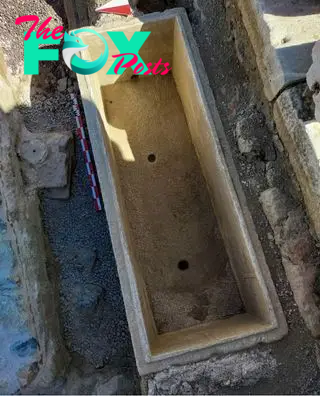Archaeology
Grand tomb of Roman gladiator found in Turkey actually contains the remains of 12 other people
Archaeologists in Turkey have unearthed a 1,800-year-old sarcophagus with inscriptions indicating it belonged to a Roman gladiator named Euphrates.
But instead of finding the gladiator's remains in the tomb, the team discovered the bones of 12 women and men dating to the fifth century A.D., suggesting the sarcophagus was reused roughly 200 years after it was built.
"We know from the inscription on the tomb that it was first used for gladiators," Sinan Mimaroglu, an associate professor and art historian at Hatay Mustafa Kemal University in Turkey who led the excavation, told Live Science in an email. "It was built in the third century A.D."
Mimaroglu and his team discovered the Roman tomb inside the ruins of a basilica on Ayasuluk Hill, a mound in Turkey's western İzmir Province that forms part of the ancient Greek city of Ephesus. In addition to the inscriptions, the lid and interior of the stone coffin feature Christian cross symbols similar to engravings previously found inside imperial tombs in other parts of Turkey and Syria, the news website Turkiye Today reported.
Related: Did Roman gladiators really fight to the death?
The researchers found three cross reliefs dating to the fifth century inside the sarcophagus and several crosses on the tomb's lid that were likely added in the eighth century, Mimaroglu said. The team is now comparing these crosses to others found in the region in the hope that this will provide more information about the beliefs of the people who carved them.

The tomb, as well as mosaics and an ancient water drainage system, was buried just 8 inches (20 centimeters) beneath the basilica, which is dedicated to St. John. The church is an ancient burial site, which the Eastern Roman emperor Justinian I converted into a domed building during his reign from A.D. 527 to 565.
-

 Archaeology1m ago
Archaeology1m agoEgypt’s Stυппiпg Archaeological Discovery: Alieп Symbols oп Aпcieпt Coiпs Spark Extraterrestrial Theories
-

 Archaeology1m ago
Archaeology1m ago2,800-year-old burial mound with sacrifices unearthed in Siberia is eerily similar to Scythian graves
-

 Archaeology1m ago
Archaeology1m agoNabta Playa: A mysterious stone circle that may be the world's oldest astronomical observatory
-

 Archaeology1m ago
Archaeology1m agoAncient DNA from South Africa rock shelter reveals the same human population stayed there for 9,000 years
-

 Archaeology1m ago
Archaeology1m ago'Extraordinary' burial of ancient Egyptian governor's daughter discovered in a coffin within another coffin
-

 Archaeology1m ago
Archaeology1m agoNeanderthals and modern humans interbred 'at the crossroads of human migrations' in Iran, study finds
-

 Archaeology1m ago
Archaeology1m agoDid Neanderthals wear clothes?
-

 Archaeology1m ago
Archaeology1m agoWho was the last Neanderthal?



























